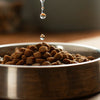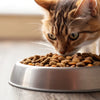What Can I Add to My Dog's Kibble? Enhancing Your Pup's Diet
- Houndsy
Table of Contents
- Introduction
- Understanding Kibble and Its Limitations
- Nutritious Additions to Kibble
- Balancing Your Dog's Diet
- Conclusion
Introduction
Did you know that over 60% of dog owners in America choose kibble as their pup's primary food? While kibble is a convenient and budget-friendly choice, it often lacks the freshness and variety that can truly benefit our furry friends. As dedicated pet owners, we all want to ensure that our dogs receive the best nutrition possible. So, what can we add to our dog's kibble to elevate their meals and improve their overall health?
In this blog post, we will explore various nutritious additions that can enhance your dog's kibble. From protein-packed options to fiber-rich vegetables, we'll cover a range of foods that not only improve taste but also boost nutritional value. By the end of this article, you'll have a wealth of ideas to make mealtime exciting and healthy for your pup, helping them thrive and enjoy their food even more.
Let’s embark on this culinary journey to discover how we can transform our dogs' kibble from ordinary to extraordinary!
Understanding Kibble and Its Limitations
The Basics of Kibble
Kibble is a popular choice due to its convenience and long shelf life. It typically contains a balanced mix of proteins, carbohydrates, and fats, designed to meet the dietary needs of dogs. However, kibble is highly processed, which can strip away some essential nutrients. Additionally, many commercial kibbles are high in carbohydrates, which, while necessary for the extrusion process, are not a nutritional requirement for dogs.
The Need for Enhancements
While kibble provides a foundational diet, it often lacks freshness and variety. Dogs, like us, can benefit from a diverse diet that includes whole foods. Adding fresh ingredients can help combat the monotony of eating the same thing daily while also providing essential nutrients that might be missing from their kibble.
Research has shown that introducing fresh foods into your dog's diet can support their immune system, promote healthy digestion, and improve their coat quality. Our goal is to enhance the kibble experience, making it not only more enjoyable but also more nourishing.
Nutritious Additions to Kibble
Now that we understand the need for enhancements, let’s dive into the various foods we can add to our dog's kibble. We’ll categorize these additions into protein sources, fruits, vegetables, healthy fats, and more.
Protein Sources
- Cooked Meat: Lean protein sources like chicken, turkey, or beef can be added to kibble in small, bite-sized pieces. This addition boosts protein intake, making meals more satisfying. Just ensure the meat is boneless and free from seasoning.
- Eggs: Whole eggs are an excellent source of protein and essential amino acids. They can be served scrambled, hard-boiled, or raw. The nutrients in eggs, especially the yolk, can enhance coat health and provide energy.
- Fish: Fish such as sardines or salmon are rich in omega-3 fatty acids, which support skin and coat health. Canned fish packed in water (without added salt) is a convenient option. Just be cautious with raw fish due to potential parasites.
- Dairy: Plain yogurt or cottage cheese can be a tasty addition that provides protein and probiotics. These dairy options can aid in digestion and contribute to a healthy gut. However, be mindful of lactose intolerance in some dogs.
Fruits
- Berries: Blueberries, strawberries, and raspberries are packed with antioxidants and can provide a sweet treat mixed into kibble. They support overall health and can add a refreshing flavor.
- Apples: Sliced apples (without seeds) are a crunchy, nutritious addition. They offer fiber and vitamins while serving as a tasty snack.
- Pumpkin: Canned pumpkin (not the spiced pie mix) is an excellent source of fiber, which can help regulate digestion. A spoonful mixed into kibble can aid in gastrointestinal health.
- Bananas: Rich in potassium and vitamins, bananas can be mashed and added to kibble for a sweet twist. They are a good source of energy, perfect for active dogs.
Vegetables
- Carrots: Raw or cooked carrots can be diced or shredded and mixed with kibble. They provide vitamins and fiber while being low in calories.
- Green Beans: These are another low-calorie option that can be served fresh or steamed. They add fiber and can help maintain a healthy weight.
- Peas: Fresh or frozen peas are rich in protein and fiber. They can be easily mixed into kibble and are usually well-received by dogs.
- Sweet Potatoes: Cooked and mashed sweet potatoes are rich in vitamins and provide a natural sweetness that many dogs enjoy.
Healthy Fats
- Olive Oil: A drizzle of olive oil can enhance the flavor of kibble while providing healthy fats that support skin and coat health. It can help with dry skin and give your dog a shiny coat.
- Fish Oil: Fish oil supplements or liquid fish can be added to kibble for a boost of omega-3 fatty acids. This is particularly beneficial for dogs with skin issues or joint problems.
- Coconut Oil: Adding a small amount of coconut oil can improve digestion and support a healthy coat. It also has anti-inflammatory properties.
Other Considerations
- Herbs: Dog-safe herbs like parsley or basil can add flavor and provide health benefits. For example, parsley can help freshen breath, while basil has anti-inflammatory properties.
- Bone Broth: A splash of homemade bone broth can add flavor and moisture to kibble. Ensure it’s free from onions, garlic, or excessive salt, which can be harmful.
- Commercial Toppers: There are various commercial dog food toppers available that can enhance kibble nutrition. Look for high-quality products that complement your dog's dietary needs.
Balancing Your Dog's Diet
Moderation is Key
While adding these nutritious ingredients can greatly enhance your dog's diet, moderation is crucial. The general guideline is that any additions should not exceed 10-20% of your dog’s total caloric intake. This ensures that their main diet remains balanced and nutritionally complete.
Monitoring Your Dog's Reaction
When introducing new foods, it's important to do so gradually. Monitor your dog's reaction to each addition, looking for any signs of allergies or digestive upset. If your dog experiences any adverse effects, consult your veterinarian.
The Role of the Houndsy Kibble Dispenser
At Houndsy, we believe that feeding time should be easy, enjoyable, and aesthetically pleasing. Our Houndsy Kibble Dispenser not only provides perfect portion control but also allows for seamless integration of these nutritious additions into your dog’s meals. Designed with ergonomic convenience and beautiful mid-century modern aesthetics, it elevates the feeding experience, making it a delightful ritual for both you and your furry friend. Explore the Houndsy Kibble Dispenser here.
Conclusion
Enhancing your dog's kibble can transform mealtime into a nourishing and exciting experience. By adding fresh proteins, fruits, vegetables, and healthy fats, we can provide our furry companions with the nutrition they deserve while keeping their meals interesting. Remember, it's all about balance and moderation, ensuring that kibble remains the foundation of their diet.
As dedicated pet owners, we have the power to make simple changes that can lead to healthier, happier lives for our dogs. So, what will you add to your dog's kibble tonight? We encourage you to experiment with different ingredients and discover what your pup enjoys most.
If you’re looking for a convenient and stylish way to serve your dog their kibble and nutritious additions, consider the Houndsy Kibble Dispenser. Elevate your feeding routine today—your dog will thank you for it!
FAQ
Can I add fruits and vegetables to my dog's kibble every day?
Yes, you can add fruits and vegetables to your dog’s kibble daily, but ensure that the total calorie intake from these additions doesn’t exceed 10-20% of their daily caloric needs.
Are there any foods I should avoid adding to my dog's kibble?
Absolutely! Avoid foods that are toxic to dogs, such as grapes, raisins, onions, garlic, chocolate, and anything with artificial sweeteners like xylitol. Always consult your veterinarian if unsure.
How do I know if my dog is allergic to a new food?
Introduce new foods one at a time and observe for signs of allergies, such as itching, gastrointestinal upset, or changes in behavior. If you notice any adverse reactions, discontinue use and consult your veterinarian.
Can I use the Houndsy Kibble Dispenser for wet food or toppers?
The Houndsy Kibble Dispenser is designed primarily for dry kibble; however, you can serve wet food or toppers separately to complement your dog’s meal.
What are the benefits of using the Houndsy Kibble Dispenser?
The Houndsy Kibble Dispenser offers ergonomic convenience, large storage capacity, and perfect portion control. It also features a stylish design that complements modern home decor, making feeding time an enjoyable experience for both you and your pet. Explore our Houndsy Kibble Dispenser to enhance your dog’s feeding ritual!












